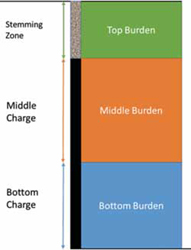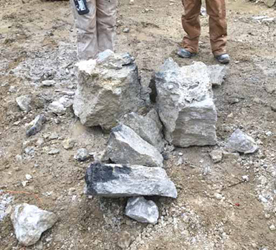
Surface charge contact area maximization (left - proper, right - poor).
Breaking Boulders in Top Burden
Stemming is widely used to ensure that a loaded borehole achieves optimum blast
results, but the practice can leave large boulders unbroken in the upper layer of burden.
The authors explore several proven methods for boulder-busting using explosives.
By Anthony Konya and Dr. Calvin J. Konya

There are many ways to break these boulders with explosives; however, it is always better to break the boulders in the blast or prevent these boulders from forming during the blasting process rather than having to break them in the muck pile after the blast.
Secondary Blasting of Boulders
Once boulders have formed, they can be
set aside in the pit; however, this can
result in lost production and rehandling
costs throughout the life of mine. More
often these boulders are broken up into
smaller sized rocks that can be more easily
removed. This can be done with mechanical
or explosive means. In this article,
explosive methods will be discussed.
It is imperative to not only select the
most economical form of breaking boulders,
but also to ensure that regulations
on environmental effects of blasting are
not exceeded. Explosive fragmentation of
boulders will require handling and possibly
drilling, will generate air overpressure,
and can result in flying debris.

There are ways to improve the results of this method: One is in explosive placement and maximizing the contact area of the charge against the boulder. In the diagram above, two examples are given of explosive placement on a boulder; the left charge has a much larger contact area and will result in significantly better breakage than the right charge. This placement is typical for emulsions and dynamites; however, if using a cast booster to shoot, the right is a more typical placement. For this reason, when using a cast booster for boulder busting choose one with a very large diameter and short length.
Another way to increase the breakage of a surface charge is to use a mudcap after placing the explosive charge, simply covering the charge with mud or clay to form a conical cap over the explosive. The cap helps to retain some of the explosive energy and direct it to breaking the boulder. By using both improvement methods for surface charges the total powder factor could possibly be brought down to 1 lb/yd3 of boulder, depending on the shape of the boulder.
Another method for breaking boulders is the drill and shoot method in which the boulder is generally drilled in approximately the middle with a borehole diameter slightly larger than the explosive charge. It should be drilled to one-half to two-thirds of the way through the boulder with the charge placed at the bottom of the borehole. With proper stemming, the powder factor for this would be approximately 100 g/yd3. This method of boulder breakage will result in significantly less air overpressure than the surface charge method, with reductions of more than 6 dB possible. It can lead to increased flyrock compared to the surface charge but the boulder will break more finely.
A modification to this method would be to add water and completely fill the drillhole. ‘Water stemming’ will then change the charge weight to around 8 g/yd3 and the charge should be hung one-half the length of the drillhole. This method can greatly reduce the amount of air overpressure (200% to 400% from a normal borehole charge), minimize flyrock, and break the boulder into four or more pieces.

Stemming Charges
Dealing with boulders by breaking them
during the blast, and avoiding secondary
blasting, provides many advantages including
reduced cost, increased production,
longer throw of material and reduced
equipment needs. This can be achieved by
putting an explosive charge of smaller diameter
into the stemming material. While
this will not cause the top burden to break
like the middle or bottom burden, it will
cause the top burden to break to a much
greater degree than without the charge.
In the past, the Livingston cratering technique was used to estimate charge depth of burial; however, this would lead to blow-out of the stemming and minimal fragmentation away from the borehole. This is because the charge would crater and eject the stemming above the borehole. If it was fired before the main charge, then the entire shot performance would be degraded. This method of breaking the top burden would also have minimal, if any, effect a few borehole diameters away from the charge.
Designing a proper explosive charge and depth of burial requires an understanding of bench blasting principles and rock breakage mechanisms. In order to maximize the amount of material broken and the distance material is broken from the hole, the bench must be placed into the bending mode of flexural failure. This can be achieved by placing the stem charge approximately 50% to 60% of the depth of the stemming. This charge will generally be a small, cartridge explosive product that has a diameter less than that of the borehole. The diameter of the charge is normally around 50% of the borehole diameter and the length of the charge should be around four to six times the diameter. The stem charge should be initiated at the same time as the main charge to prevent blow-out of stemming or throwing of the stem charge. This is accomplished with the use of detonating cord from the top of the main charge to the stem charge. This simple method can then be used to easily achieve better breakage of the top burden and minimize or eliminate secondary blasting on-site.
To refine this method further, the authors have developed a simple ratio that can be used in different situations. This is assuming that the amount of stemming above the charge is reasonable and the rest of the blast is reasonably designed. A good way to tell if the stemming is adequate is to video record the blast and analyze whether the stemming is ejected from the borehole.If ejected, it is not properly designed.
The ratio for designing stem charges
is below:

Calvin Konya is the founder of Precision
Blasting Services (PBS) and Anthony
Konya serves as project engineer for PBS.
www.idc-pbs.com